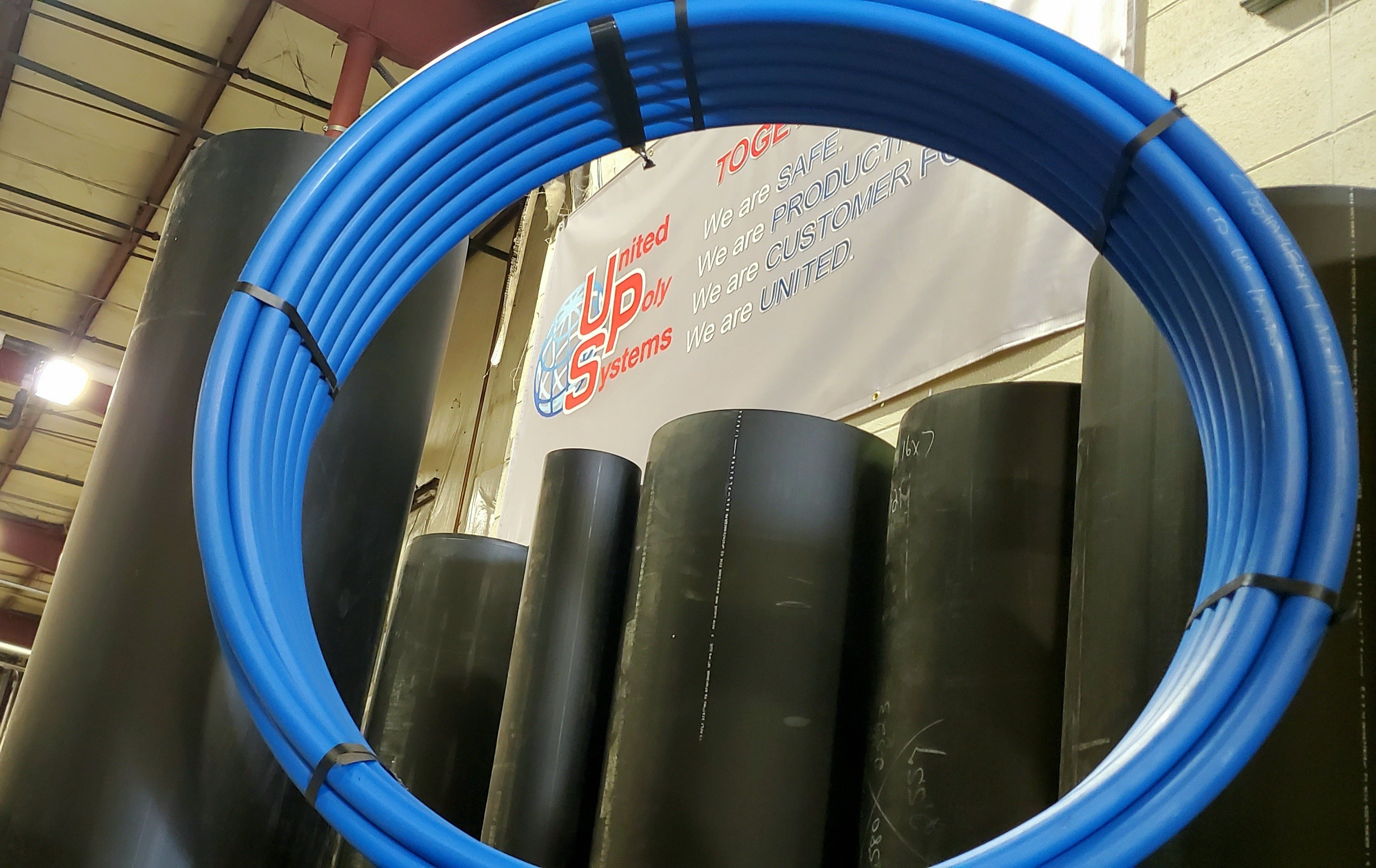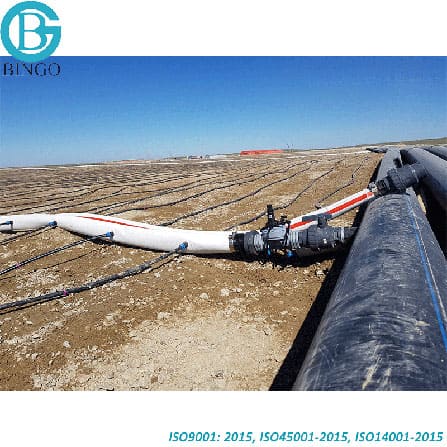Where to Find hdpe pipe in stock Midland TX for Urgent Projects
Wiki Article
Explore the Production Process Behind High-Quality HDPE Pipe and Its Applications
The production procedure of high-grade HDPE pipelines is elaborate and methodical. It begins with the choice of basic materials that boost efficiency. Following this, ethylene undertakes polymerization to form resin, which is after that formed via extrusion. Quality assurance is vital, guaranteeing that the end product meets strict criteria. Nevertheless, the journey of HDPE pipes doesn't finish with manufacturing. Their applications throughout various sectors reveal a wider relevance worth analyzing.Comprehending HDPE: Properties and Advantages

High-density polyethylene (HDPE) is a versatile polycarbonate known for its longevity and resistance to different ecological factors. This material displays superb tensile stamina, making it suitable for demanding applications. Its low-density structure contributes to a light-weight product, facilitating convenience of dealing with and setup. HDPE also showcases exceptional resistance to chemicals, which minimizes destruction when revealed to extreme compounds.
The product's reduced dampness absorption further boosts its long life, making it optimal for use in pipes and tank. Additionally, HDPE is immune to ultraviolet (UV) radiation, making sure that items maintain their honesty also when revealed to sunshine. Its adaptability enables for the production of elaborate forms without jeopardizing stamina. The green nature of HDPE, usually derived from recycled materials, includes to its appeal, promoting lasting methods in manufacturing. On the whole, these residential properties and benefits make HDPE a preferred choice for various commercial and consumer applications.
Resources Selection for HDPE Production
The selection of resources for HDPE manufacturing is necessary to verify the last item meets the wanted requirements and high quality criteria. High-density polyethylene (HDPE) is primarily produced from polymerized ethylene, stemmed from fossil gas such as natural gas or petroleum. The top quality of these feedstocks substantially affects the mechanical and thermal residential properties of the last HDPE.Additives likewise play a significant duty in boosting HDPE's efficiency, consisting of antioxidants, UV stabilizers, and colorants, which enhance longevity and resistance to environmental aspects. The selection process need to take into consideration not only the chemical structure of the raw products yet additionally their processing features to guarantee reliable manufacturing.
The sourcing of raw materials should focus on sustainability and compliance with ecological guidelines, as accountable methods are essential in today's market. Eventually, cautious basic material option lays the structure for creating high-grade HDPE pipes suitable for diverse applications.
The Extrusion Refine: Shaping HDPE Pipe
The extrusion process plays an essential role fit HDPE pipelines, starting with careful product prep work methods that ensure excellent flow and uniformity. Equally essential is the layout of the die, which directly influences the final dimensions and surface area quality of the pipe. Together, these factors add greatly to the efficiency and quality of HDPE pipeline production.Material Preparation Techniques
Effective production of HDPE pipelines begins with precise material prep work techniques, particularly the extrusion procedure. Throughout this stage, high-density polyethylene material is very first dried to get rid of moisture, ensuring ideal flow characteristics. The material is after that fed right into the extruder, where it goes through heating and melting, changing right into a thick state. This home heating process is meticulously controlled to preserve the material's stability and efficiency. The molten HDPE is required via a die, shaping it into a continual pipe kind. Correct temperature level administration during extrusion is vital, as it directly impacts the material's residential or commercial properties and the end product top quality. As soon as shaped, the HDPE pipeline is cooled and cut to specified lengths, ready for subsequent handling and applications.Die Style Significance
Precision in die design plays a necessary role in the extrusion process of HDPE pipelines. The die acts as the last shaping tool, directly influencing the pipe's measurements, wall surface density, and surface coating. A properly designed die assurances uniform product flow, lowering defects such as abnormalities and weak points. The geometry of the die must be maximized to fit the details residential or commercial properties of HDPE, including its thickness and thermal behavior during extrusion. In addition, the cooling price of the product as it goes through the die can markedly affect the pipeline's architectural honesty. More hints As a result, buying advanced die modern technology is important for producers intending to produce high-grade HDPE pipes that meet industry requirements and consumer expectations.Top Quality Control Actions in HDPE Manufacturing
Although various variables affect the top quality of HDPE pipe manufacturing, effective quality assurance procedures are critical to assure consistency and integrity in the final product. Key quality assurance practices include strenuous product assessment, verifying that the raw polyethylene fulfills recognized criteria for pureness and density. Throughout the extrusion procedure, criteria such as temperature, pressure, and cooling time are closely kept track of to maintain dimensional precision and structural stabilityOn top of that, post-production testing is essential; makers usually conduct hydrostatic examinations to examine the pipeline's toughness and resistance to pressure. Visual gas pipe installation inspections for surface area defects even more boost top quality assurance. Qualification from relevant standards organizations, like ASTM or ISO, provides an extra layer of reputation. By applying these extensive quality control measures, manufacturers can minimize flaws, enhance performance, and make certain that the HDPE pipes satisfy the certain needs of different applications, eventually leading to consumer satisfaction and trust fund in the item.
Applications of HDPE Pipe Across Industries
HDPE pipes are utilized across different markets due to their resilience and flexibility. In water circulation systems, they guarantee reliable delivery, while in wastewater administration, they provide reputable services for waste transportation. Additionally, agricultural irrigation networks take advantage of HDPE's resistance to rust and versatility, making it a perfect selection for modern farming methods.
Water Distribution Systems
A significant number of industries rely upon high-density polyethylene (HDPE) pipelines for reliable water circulation systems. Understood for their toughness and resistance to deterioration, HDPE pipes are widely utilized in community water supply networks, farming irrigation, and industrial applications. Their lightweight nature facilitates very easy handling and installation, reducing labor costs and time. Additionally, HDPE pipelines can suit numerous stress levels, making them suitable for both low and high-pressure systems. American Plastics HDPE Pipe Manufacturing. The adaptability of the material allows for smooth assimilation right into existing facilities, reducing the requirement for comprehensive excavation. Furthermore, HDPE's resistance to chemical leaching warranties that the water delivered remains risk-free and clean, making it an optimal choice for preserving the quality of potable water across numerous industriesWastewater Administration Solutions
Reliable water circulation systems sewer line camera inspection additionally lead the way for innovative wastewater monitoring solutions, where high-density polyethylene (HDPE) pipelines play a substantial duty. Distinguished for their longevity and resistance to rust, HDPE pipes are optimal for transporting wastewater in various settings. Their versatility enables for simple installment in intricate atmospheres, reducing the need for comprehensive excavation. Furthermore, HDPE's smooth interior surface area decreases friction, boosting flow prices and effectiveness. These pipelines are also immune to chemical leaching, ensuring that impurities do not jeopardize the surrounding atmosphere. Industries, districts, and therapy centers increasingly count on HDPE pipes for their integrity and long life, making them a preferred option for modern wastewater administration systems. This flexibility emphasizes the vital relevance of HDPE pipes across numerous applications.Agricultural Watering Networks
Agricultural irrigation networks benefit considerably from the usage of high-density polyethylene (HDPE) pipelines, which give reliable and dependable water delivery to plants. HDPE pipes are lightweight, making them easy to transfer and mount, while their flexibility permits for different setups in diverse surfaces. These pipelines show excellent resistance to corrosion, chemicals, and UV radiation, ensuring resilience in rough agricultural environments. Additionally, their smooth interior surface decreases friction loss, enhancing water circulation and decreasing energy costs related to pumping. The durability of HDPE pipes, often going beyond half a century, adds to lower maintenance and substitute expenditures. Farmers progressively count on HDPE pipelines to enhance irrigation efficiency and promote sustainable agricultural methods, eventually leading to boosted plant yields and resource preservation._-_Post_di_Facebook_-_Dimensioni_personalizzate_(1)_60cafdf20856f.png)
Future Patterns in HDPE Pipe Innovation
As the demand for sustainable and efficient framework grows, advancements in HDPE pipeline innovation are poised to transform various sectors. Emerging patterns include the integration of smart innovations, such as sensors and IoT capacities, which facilitate real-time tracking of pipe conditions, lowering upkeep expenses and avoiding leaks. Additionally, the advancement of innovative production techniques, such as 3D printing, is making it possible for the production of complicated, customized pipeline designs that satisfy specific task requirements.The focus on recycling and circular economic climate techniques is driving the technology of HDPE pipes made from recycled materials, enhancing sustainability. Improved jointing techniques, such as electro-fusion and mechanical installations, are also enhancing installment performance and dependability. Finally, the growing focus on environmental policies is pushing producers to adopt greener manufacturing procedures, making sure that HDPE pipelines not only fulfill sector requirements but likewise foster an even more lasting future for infrastructure development.
Regularly Asked Questions
Just How Does HDPE Contrast to Various Other Plastic Products?
HDPE outperforms lots of other plastic products relating to durability, chemical resistance, and flexibility. Its reduced density and high tensile strength make it ideal for numerous applications, commonly exceeding options in both efficiency and longevity.What Are the Environmental Impacts of HDPE Manufacturing?
The ecological impacts of HDPE manufacturing include greenhouse gas emissions, power usage, and potential pollution from making processes. In addition, inappropriate disposal can bring about dirt and water contamination, increasing problems regarding long-term environmental results.Can HDPE Water Lines Be Reused?
Yes, HDPE pipelines can be reused. Several centers accept utilized HDPE for handling, transforming it into brand-new products. This reusing contributes to sustainability efforts, decreasing plastic waste while preserving sources and energy in the production cycle.What Is the Life Expectancy of HDPE Piping?

Exactly How Do Temperature Variants Impact HDPE Pipeline Performance?
Temperature level variations substantially affect HDPE pipeline efficiency, affecting versatility and stamina. High temperature levels can bring about softening, while reduced temperature levels may trigger brittleness, ultimately influencing the pipeline's sturdiness and viability for numerous applications in diverse settings.Report this wiki page